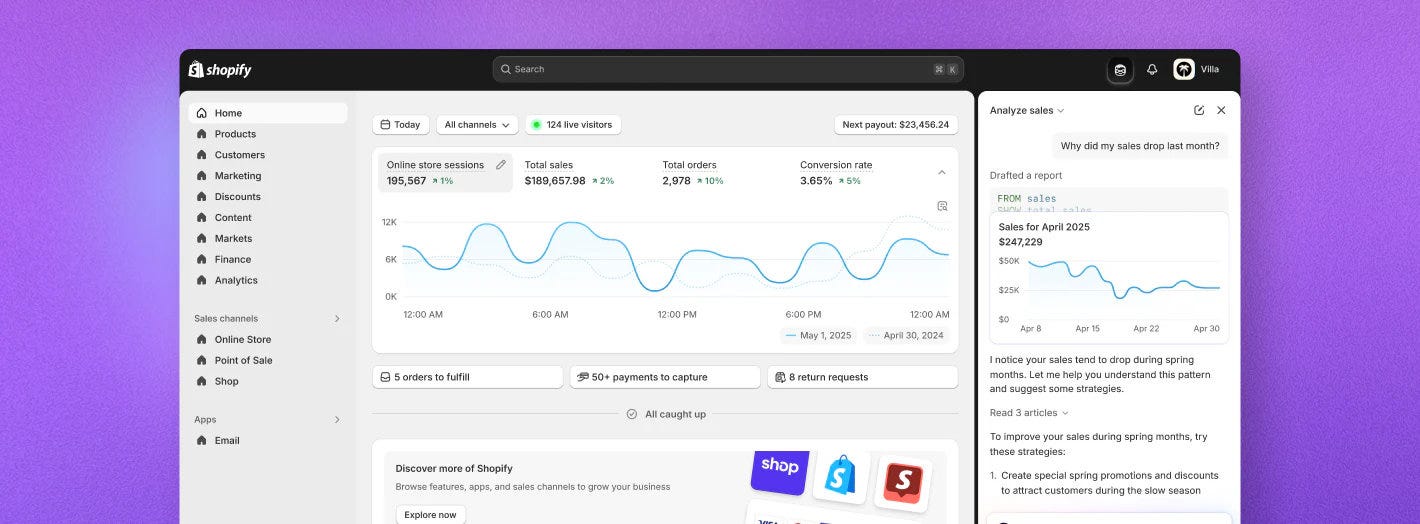How Shopify's AI-First Mandate Turbocharges Its Already Unbeatable eCommerce Strategy
While competitors bolt on AI features, Shopify uses AI to eliminate entire categories of work, creating speed advantages that compound faster than rivals can respond
🎯 My goal for the next 12 months is to help you become a 50% more strategic leader, with at least a 20X return on investment through exclusive case studies, proven frameworks, community insights, and direct access to strategic thinking that drives real business results.
As part of Product Strategy Decoded, you’re able to:
Think strategically, not just tactically – Transform from someone who executes orders to someone who sets the strategic direction, with frameworks and mental models that help you connect the dots from strategy through execution.
Join a community of strategic practitioners – Get access to our subscriber-only community chat where fellow strategic leaders share real-world applications, challenges, and wins from implementing these frameworks.
Stay ahead of the curve – Receive subscriber-only deep dives, live strategy breakdowns, and occasional webinars where we tackle the most pressing strategic challenges facing today's leaders.
The tech press thought Shopify's 2025 "prove AI can't do it before hiring" mandate was a call for them to become an AI-first company.
They missed the point entirely.
Shopify CEO Tobias Lütke isn't interested in becoming the next OpenAI. He's weaponizing AI to accelerate competitive advantages that BigCommerce, Adobe Commerce, and WooCommerce already can't match.
While those companies scramble to add AI features, Shopify eliminates merchant setup time from months to hours, automates ecosystem partner support, and turns customer success into a self-reinforcing competitive moat.
The result: AI is enabling Shopify to compound its strategic advantages faster than competitors can respond.
Shopify’s AI Advantage to the Rescue

Launch day was supposed to be her triumph. It nearly ended in disaster.
Shari Gail Chua had spent months crafting the perfect launch strategy for Softlife Sleepwear, her premium cotton and bamboo pajama line.
She'd built a devoted following through authentic storytelling, sharing her design journey, and gathering feedback on materials, color, fit, patterns, long before her Shopify store went live.
When eager customers couldn't complete checkout, they flooded her inbox with complaints. Orders were abandoned. Months of careful audience-building started evaporating in real-time as frustrated fans were giving up and going elsewhere. On any other commerce platform, this would have meant frantic support tickets, days of back-and-forth troubleshooting, and potentially catastrophic loss of reputation and revenue.
But Shari Gail turned to Shopify's "Sidekick" AI assistant. In minutes, she discovered the problem: she'd forgotten to disable payments test mode.
One click rapidly fixed what could have been a lengthy, business-ending crisis.
Things Get Better… Then Worse…
Plot twist: her quick recovery now created an even bigger, although much higher-quality, problem.
Her committed fanbase flooded her site so hard that she sold out her entire seasonal inventory in a single week. Again, Sidekick came to the rescue, analyzing which colors, styles, and sizes to restock first based on data from her first batch of orders, cross-referenced with thousands of similar stores. What would have been guesswork became confident, data-driven reordering from her supplier.
What might seem like Shari Gail's "lucky" recovery was the result of a series of Shopify’s strategic choices in action.
The Waymo Advantage in a Manual Transmission World
Think of it like this: while BigCommerce and WooCommerce customers are still grinding gears in old, clunky manual transmission cars, Shopify hands its shop owners fully autonomous, self-driving Waymo cars.

You might enter the same destination into both vehicles, but the driving experience couldn’t be more different.
While Shari Gail was solving her checkout crisis in minutes, sleepwear competitors on other platforms were still panicking as they waited for human support responses. That speed and stress differential speaks to the core of Shopify's competitive advantage.
Untouchable
The same AI infrastructure that saved Shari Gail's launch also auto-generates product descriptions in 30 seconds, creates images on the fly, predicts inventory needs, and optimizes checkout flows based on millions of similar stores.
This is Shopify’s AI-as-strategy in action. Nothing screams "AI," but under the hood, nearly every key e-commerce business operation runs at 10X speed.
But how did Shopify engineer this AI-powered competitive advantage? And more importantly, how can you apply these same principles before your competitors catch on?
To decode the choices enabling Shopify's success, we’ll reverse-engineer them using Roger L. Martin's "Strategy Choice Cascade" framework.






